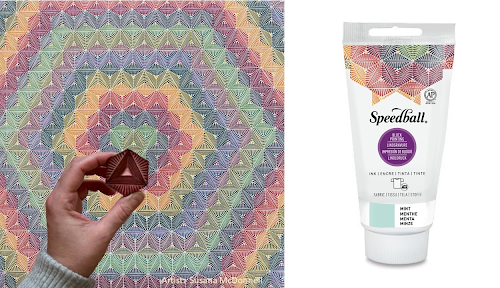Winsor & Newton has reintroduced five single pigment colors to their Professional Water Colour collection. Back due to popular demand, the five new core colors were previously limited editions. Discover the stories behind the colors and share these fun facts with your customers as you celebrate World Watercolor Month in July!
Transparent Orange
The word orange was first used exclusively to describe the citrus fruit, while the artists’ color was called yellow red. One of the first examples of the word orange as a color, was in 1502 when Elizabeth of York described a fabric as “slevys of orenge colour sarsenet”. Artist and theorist Wassily Kandinsky described orange as “like a man convinced of his powers” in his seminal 1911 work, ‘Concerning the Spiritual in Art’, implying the confidence that orange holds and communicates.
Quinacridone Violet
Quinacridone Violet is based on the transparent Quinacridone pigment introduced in the 1950s. Quinacridone is a synthetic pigment which is loved for its signature combination of naturally intense color and transparency. It gives us a range of colors from yellow to orange, red to violet and is considered high performing due to its color intensity and lightfastness.
Aqua Green
The color green is traditionally associated with the natural world and spring rites. In the past, mixing some colors (including green) was seen as taboo and anyone caught doing this could face punishment. This began to change during the Renaissance and artists happily mixed blue and yellow to make varying hues of green until 1775, when Swedish chemist Carl Wilhelm Scheele discovered Copper Arsenite, a green that would be very popular, but unfortunately contained a large amount of poison.
Smalt (Dumont’s Blue)
A bright variation on Cobalt Blue, Smalt, also known as Dumont’s Blue, is an iconic single pigment color. Traditionally used to color stained glass and pottery, Smalt comes from the grinding of Cobalt blue glass and became popular with classical painters, including Veronese, Vermeer, van Dyck, Rubens and Hogarth, from around 1550 to 1730.
In 1890 J. Scott Taylor, Scientific Director at Winsor & Newton for over 50 years, labelled a small jar ‘best quality Smalt’. In 2006, Winsor & Newton’s Senior Research Chemist opened the jar and formulated the closest modern alternative to the archive color: a unique, beautiful blue that wouldn’t be able to be mixed from available watercolors.
Cobalt Green Deep
Cobalt Green was first discovered in 1780 by Swedish chemist and mineralogist Sven Rinman, when heating Cobalt and Zinc—a process documented in Arthur Herbert Church’s 1901 book ‘The Chemistry of Paints and Painting’. It is sometimes called Rinman’s Green.
The name Cobalt comes from the German mythical creature ‘Kobolt’ (or ‘Kobold’)—a goblin or sprite blamed by medieval miners for the poisonous nature of arsenic ores of the metal Cobalt. The myth has survived through the ages and today Kobolds appear in the popular ‘World of Warcraft’ gaming series. The Cobalt Green pigment has recently been found to be useful for scientists working in the emerging field of spintronics. Here they are putting the non-volatile, magnetic, semi conductive qualities of the pigment to use to create new capabilities for technologies. If successful, Cobalt Green could help our computers start up immediately, like switching on a light, instead of needing systems to load.
Submitted by Winsor & Newton






